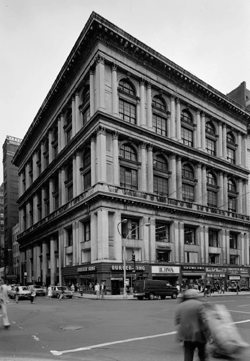
One of the most important preservation-related governmental developments was the establishment of the National Park Service (NPS) within the Department of the Interior in 1916. The NPS was created in large part to take over the maintenance and administration of sites too large to be cared for by private preservation entities, such as Jamestown. Today, the NPS oversees many programs related to historic preservation, including the National Register of Historic Places, Heritage Preservation Services, Historic American Buildings Survey (HABS), Historic American Engineering Record (HAER), Historic American Landscape Survey (HALS), and the National Center for Preservation Technology and Training (NCPTT).
Though government was becoming increasingly involved in historic preservation, many large scale efforts were still being undertaken by private individuals. In 1926, automobile tycoon Henry Ford began collecting historic buildings and objects, such as the Wright Brothers Bicycle Shop, at Greenfield Village in Dearborn, Michigan. That same year John D. Rockefeller, Jr., began funding the reconstruction and restoration projects at Williamsburg, Virginia. While neither of these large scale efforts has been without critics, they serve to show how involved the private sector was in preservation before the mid-twentieth century.
By the early twentieth century, architecture, site, and neighborhood were gaining significance as motivations for preserving historic built resources. In 1931, Charleston, South Carolina, became the first city in the U.S. to establish a historic district with regulatory control. Despite the lack of legal precedent and enabling legislation, Charleston formed a historic zoning ordinance and a board of architectural review. The success of the risky venture was due largely to the community, who supported the efforts in order to prevent the destruction of many of Charleston’s historic buildings occurring at the time.
Charleston’s historic district became the template for subsequent historic district formations. The Vieux Carre section of New Orleans had been unofficially designated a historic district in 1925, through efforts to preserve the French Quarter. In 1936, Louisiana amended its state constitution to formally authorize the Vieux Carre historic district. Other historic district designations followed in the next two decades, including San Antonio, TX, in 1939, Alexandria, VA, in 1946, Williamsburg, VA in 1947, Winston-Salem, NC, in 1948, and Georgetown, in the District of Columbia, in 1950.
When the Great Depression hit the U.S. in 1929, the federal government began to take a larger role in preservation. As part of the effort to increase employment rates through New Deal policies, President Franklin Roosevelt authorized the formation of the Historic American Buildings Survey, or HABS, in 1934. HABS was the result of an agreement among the NPS, the Library of Congress, and the American Institute of Architects, and it sent thousands of people to work photographing, drawing, measuring, and surveying historic built resources. The program fell to the wayside during the 1940s, but experienced a resurgence in the 1950s, and remains active today. Continuing with the purpose of documentation, the Historic American Engineering Record (HAER), and the Historic American Landscape Survey (HALS) were established as well, in 1969 and 2000, respectively.
Following the formation of HABS, the U.S. Congress passed the Historic Sites Act, which created the National Historic Landmarks Program and served as a means to construct preservation policy.
As part of the movement of preservation toward the inclusion of various historic sites, the National Council of Historic Sites and Buildings formed in the late 1940s. In 1949, through a Congressional Charter signed into law by President Truman, the National Trust for Historic Preservation (NTHP) formed. The NTHP was created to serve as a connective historic preservation thread between the government and private sectors. The NTHP is now the largest historic preservation non-profit in the U.S., with activities including instituting important programs, forming partnerships, advocating policy in Congress, and hosting an annual preservation conference, among other efforts. Though they worked in concert with the federal government for many years, the NTHP became independent of federal funding in 1998.
